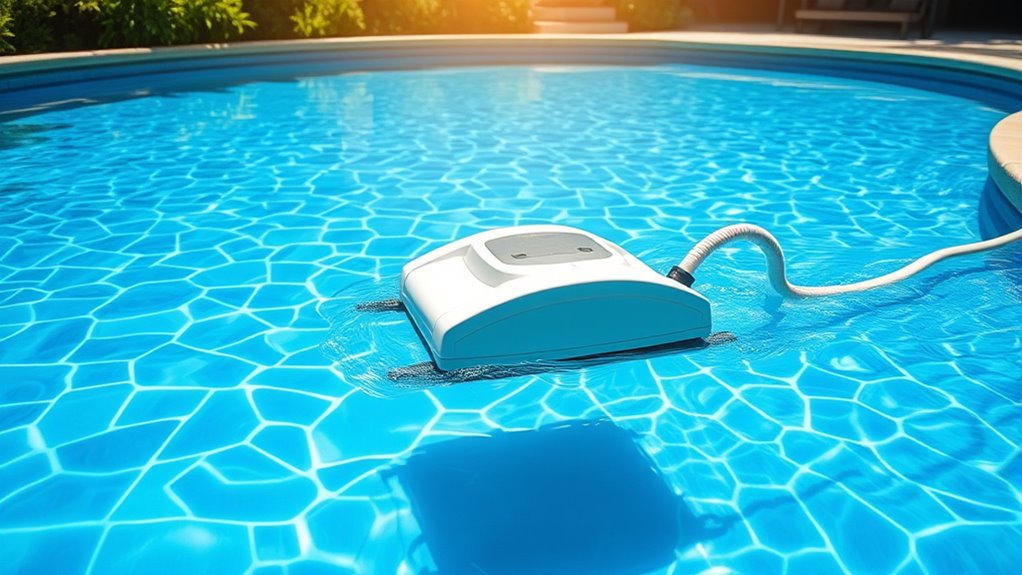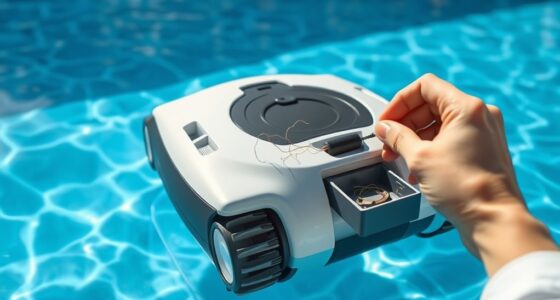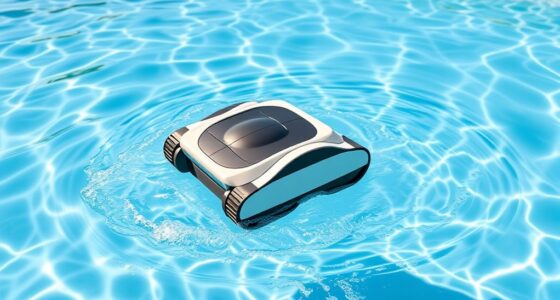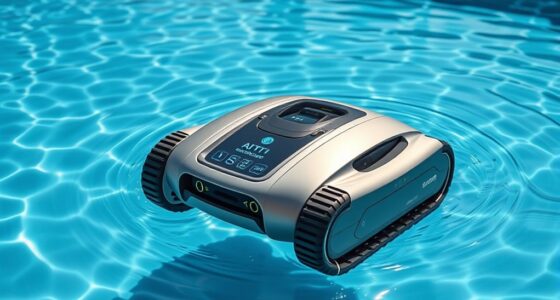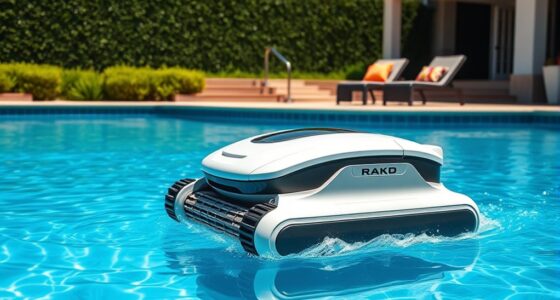If you want an energy-efficient, cost-effective pool cleaner that works well on various surfaces, a suction pool cleaner is your best choice. It attaches directly to your filtration system, making installation simple and maintenance affordable. Suction cleaners are ideal for moderate to large pools and handle fine dust, debris, and embedded dirt effectively. If you want to learn more about when and why to choose a suction cleaner, keep exploring these expert insights.
Key Takeaways
- Ideal for large or irregular pools due to their ability to cover extensive surfaces efficiently.
- Suitable when you prefer a low-energy, cost-effective cleaning solution with minimal maintenance.
- Best when your pool has a compatible filtration system that can support strong suction performance.
- Effective for cleaning diverse surfaces, including tiles, fiberglass, and porous materials, without damaging delicate linings.
- Suitable for users seeking a simple, automatic cleaner that connects directly to existing skimmer or suction lines.
Understanding the Mechanics of Suction Pool Cleaners

Suction pool cleaners work by attaching to your pool’s filtration system and using its suction power to move around the pool. As water flows through the cleaner, it creates a strong vacuum that pulls in debris from the pool floor and walls. This suction power is essential for effective debris removal, allowing the cleaner to pick up dirt, leaves, and small particles efficiently. You’ll find that these cleaners operate quietly and require minimal intervention once set up. They follow a straightforward mechanism: water is drawn in, debris is captured in a filter bag, and clean water is returned to the pool. The effectiveness of suction pool cleaners also depends on the suction power of your filtration system, making it a crucial factor in their performance. Proper maintenance of your filtration system can significantly maximize cleaning efficiency and extend the lifespan of the cleaner. Ensuring that your pool’s filtration system is regularly checked and maintained helps sustain optimal performance of suction pool cleaners. Understanding this process helps you appreciate how suction pool cleaners keep your pool tidy with consistent debris removal.
Pool Size and Shape Considerations

When choosing a suction pool cleaner, considering your pool’s size and shape is crucial for ideal performance. The pool shape influences how well the cleaner navigates, especially in irregular or complex layouts. For example, pools with many corners or steps may require a model with precise maneuverability. Pool depth also matters; deeper areas can challenge certain cleaners, so ensure the device can handle varying depths without losing suction or coverage. If your pool is large, a powerful suction cleaner with longer runtime is essential to cover the entire area efficiently. Conversely, small or shallow pools may benefit from compact models that are easier to maneuver. Matching your pool’s shape and depth with the cleaner’s capabilities ensures thorough cleaning and minimizes missed spots. Additionally, understanding how home heating solutions influence your decision can help you select a cleaner that best fits your needs and lifestyle. Considering pool size and shape as part of your overall pool maintenance plan can also optimize cleaning efficiency and prolong the life of your equipment. Proper assessment of these factors can help prevent cleaning gaps and ensure your pool remains pristine. Recognizing the importance of vetted products and accessories can further enhance your pool maintenance routine.
Budget-Friendly Maintenance Options

Opting for budget-friendly maintenance options can save you money without sacrificing cleanliness. To get the best value, compare costs and warranty coverage across different models. Here are three tips:
- Perform regular filter cleaning to extend the cleaner’s lifespan and reduce replacement costs. Regular maintenance can prevent costly repairs and improve overall performance. Incorporating knowledge of self-watering planters can help you understand how consistent care reduces long-term expenses.
- Choose models with longer warranty coverage—it protects you from unexpected expenses during repairs.
- Compare the cost of replacement parts to guarantee affordability over the long term, especially for critical components like brushes or hoses. Being aware of cost-effective parts can help you plan for future expenses.
- Regular maintenance and understanding different yoga practices can help ensure your pool cleaner operates efficiently for years to come. Additionally, understanding Glycolic Acid benefits can inform skincare routines that promote healthier skin after pool use. Incorporating knowledge of vetted home theatre projectors can also enhance your entertainment setup and overall home environment.
Ease of Installation and Setup
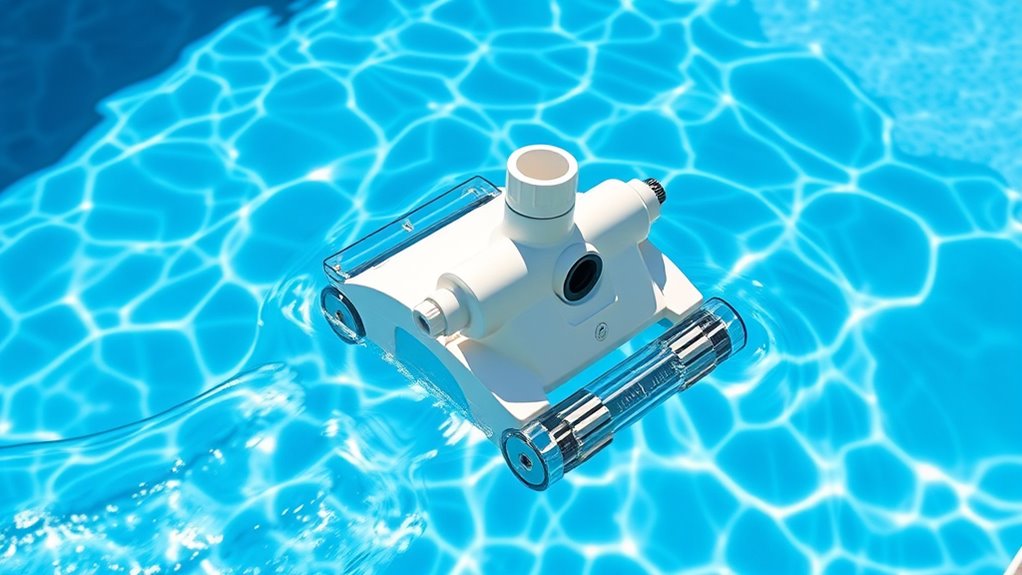
Choosing a pool cleaner that’s easy to install and set up can save you time and frustration. Suction pool cleaners excel in setup simplicity, often requiring minimal tools and effort. They typically connect directly to your skimmer or dedicated suction line, avoiding complex installation challenges. To help you evaluate, consider this:
| Feature | Benefits |
|---|---|
| Simple connection | Quick setup without special tools |
| Minimal steps | Less time spent on installation challenges |
| Lightweight design | Easy to handle during setup |
| Automatic operation | No complicated programming needed |
With straightforward installation, you’ll enjoy hassle-free maintenance. Suction cleaners are ideal if you want a reliable, low-effort solution that gets your pool clean without the headache of complicated setup procedures. Reliable performance is a key advantage of choosing a suction pool cleaner, especially since their ease of installation is well-supported by their simple design and compatibility. Additionally, their compatibility with various pool types ensures versatile use across different pool setups. Furthermore, low maintenance requirements contribute to their popularity among pool owners seeking hassle-free cleaning solutions.
Effectiveness in Cleaning Different Surfaces

Suction pool cleaners are highly effective at cleaning a variety of surfaces, making them versatile for different pool types. They adapt well to various surface textures, ensuring thorough cleaning regardless of pool design. Depending on the debris type, they excel at removing:
- Fine dirt and dust from smooth surfaces like tiles or fiberglass
- Larger debris such as leaves and twigs on textured surfaces like pebble or gunite
- Embedded dirt in rougher surfaces, including algae or sediment in porous materials, which can be particularly challenging for some cleaning methods
Their suction power enables deep cleaning across these surface textures, although performance may vary with debris size and type. Proper maintenance of the cleaner also plays a crucial role in maintaining its effectiveness over time. Additionally, understanding the specific surface material of your pool can help you select the most suitable cleaning method. For pools with consistent debris or specific surface challenges, suction cleaners provide reliable, efficient cleaning without the need for manual intervention. Using a cleaner designed for surface compatibility can optimize its performance and longevity. Regularly checking the filter system ensures optimal suction and cleaning efficiency. Incorporating advanced automation features may further enhance cleaning efficiency and reduce manual oversight.
Compatibility With Existing Pool Systems

Before choosing a suction pool cleaner, you need to check if it works with your current pool setup. Consider your pool type, how easy it is to connect to your plumbing, and how well it integrates with your pump system. Ensuring compatibility helps your cleaner operate smoothly and effectively. Additionally, verify if your pool’s filtration system can support the cleaner’s operation without overloading or causing issues power consumption of heated mattress pads. Being aware of the digital literacy programs available can also assist in understanding how to better manage and troubleshoot your pool equipment.
Pool Type Compatibility
Understanding your pool’s existing system is crucial when considering a suction pool cleaner, as compatibility varies depending on the pool type. Your pool’s surface and lining influence the cleaner’s effectiveness and longevity. Here are key points to contemplate:
- Pool surface compatibility: Suction cleaners work best with smooth surfaces like concrete, vinyl, or fiberglass. Rough or textured surfaces may require different cleaning solutions.
- Pool lining considerations: Delicate linings, such as vinyl, need gentle handling to avoid tears or damage caused by the cleaner’s suction or brushes.
- Pool size and shape: Larger or irregularly shaped pools might need customized suction setups or additional features for thorough cleaning.
Matching your pool type with the cleaner’s capabilities guarantees maximum performance and reduces potential damage.
Plumbing Connection Ease
Ensuring your pool’s plumbing system is compatible with a suction cleaner can make installation smoother and maintenance easier. Suction pool cleaners attach directly to your skimmer or dedicated suction line, so it’s important that your existing plumbing supports this connection. Check that your pool’s plumbing can handle the added flow without disrupting water circulation or affecting pool chemical balance. Variations in water temperature can also influence how well the cleaner functions, as colder water might slow suction power. Make sure your system’s fittings are compatible and that there’s adequate suction pressure. Proper plumbing compatibility minimizes issues like leaks or insufficient cleaning coverage, saving you time and effort. Confirming these factors before installation ensures your suction cleaner operates efficiently within your pool’s current setup.
Pump System Integration
Your pool’s pump system must be compatible with a suction cleaner to guarantee ideal performance. Ensuring proper integration maximizes suction power and prevents system issues. First, check if your pump’s flow rate matches the cleaner’s requirements; mismatched flow can reduce efficiency. Second, verify that your pump’s pressure can handle the suction cleaner without overworking, which may damage the system. Third, confirm that your skimmer and suction ports are designed to support the cleaner’s connection, preventing leaks or loss of suction. Proper pump system integration ensures the suction cleaner operates smoothly, maintaining excellent suction power. If these factors align, you’ll enjoy effective cleaning without putting undue stress on your pool’s pump system.
Energy Efficiency and Operating Costs
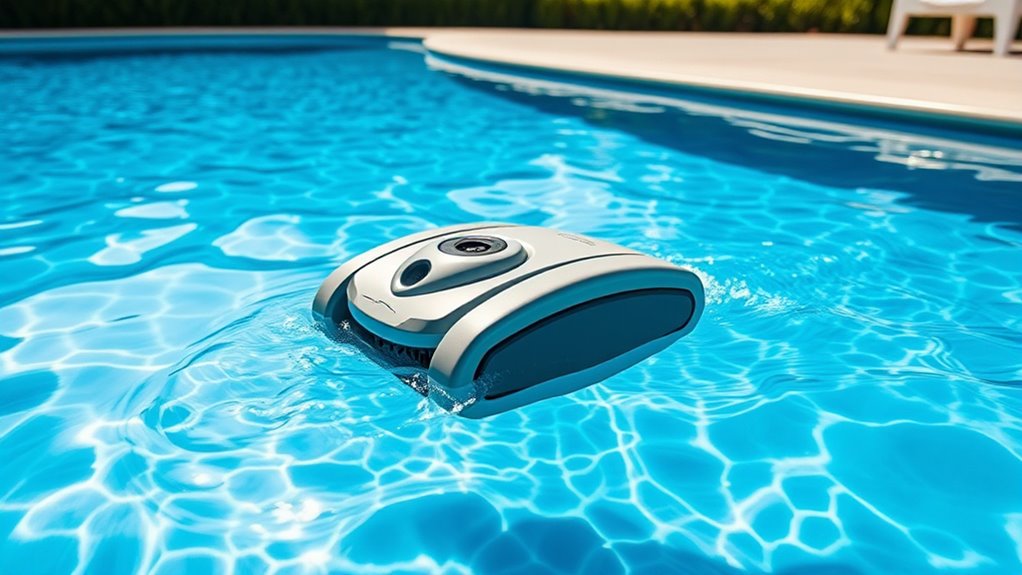
Suction pool cleaners typically use less energy than other types, helping you save on electricity bills. They also tend to have lower maintenance costs because of simpler designs and fewer parts. Understanding these benefits can make a suction cleaner a smart choice for your pool.
Lower Power Consumption
Because suction pool cleaners typically operate with less power, they consume less energy during each cleaning cycle. This results in significant energy savings and improved power efficiency over time. You’ll notice lower electricity bills while maintaining a clean pool. To maximize these benefits, consider that suction cleaners often:
- Use minimal motor power, reducing overall energy consumption.
- Require less frequent maintenance, saving costs and energy during repairs.
- Operate quietly, indicating efficient power use without excess noise.
Reduced Maintenance Expenses
Reduced maintenance expenses are a key advantage of suction pool cleaners, thanks to their energy-efficient design and simple mechanics. They require fewer parts and less frequent repairs, saving you money over time. Plus, because they operate quietly and consistently, your water temperature remains stable, reducing the need for additional heating costs. Maintaining proper chemical balance also becomes easier, as these cleaners minimize debris buildup that can disrupt water chemistry. To help you compare, here’s a quick overview:
| Benefit | Impact |
|---|---|
| Lower energy use | Reduced electricity bills |
| Fewer repairs | Decreased maintenance costs |
| Stable water temperature | Less heating needed |
| Easier chemical balancing | Fewer chemicals required for water quality |
Choosing a suction cleaner can cut down on operating expenses while keeping your pool in pristine condition.
Frequency and Duration of Cleaning Cycles

Determining the right frequency and duration for your suction pool cleaner’s cycles depends on factors like pool size, usage, and surrounding debris. Typically, you should modify your cleaning schedule based on these considerations:
- Run the cleaner 2-3 times per week during peak usage or heavy debris seasons.
- Extend cleaning durations during seasonal cleaning routines to ensure thorough debris removal.
- Use shorter, more frequent cycles if you’re actively managing pool chemical levels and want to keep the water balanced.
Regular cleaning helps maintain proper pool chemical management and prevents algae buildup. Adjust cycles based on debris accumulation, pool size, and your routine to keep your pool pristine without overworking the cleaner.
Troubleshooting Common Issues

Even the most reliable suction pool cleaners can encounter common issues that disrupt their performance. If your cleaner isn’t picking up debris effectively, start by checking the pool’s chemical balance; imbalanced water can affect suction and filtration. Clogged hoses or filters are another culprit—regularly clean and inspect these parts to maintain ideal flow. During seasonal storage, ensure the cleaner is thoroughly rinsed and dried to prevent mold and damage. If the cleaner stalls or doesn’t move smoothly, verify that the skimmer and pump baskets aren’t blocked. Also, ensure the vacuum’s intake is free of obstructions. Addressing these issues promptly keeps your suction cleaner running smoothly and prolongs its lifespan, especially after periods of seasonal storage.
When to Upgrade to Robotic or Pressure Cleaners

While suction pool cleaners are effective for regular maintenance, there are times when upgrading to robotic or pressure cleaners makes sense. If your pool has heavy debris or hard-to-reach spots, consider robotic upgrades for thorough cleaning. Additionally, if you want less manual effort and more automation, robotic cleaners offer convenience and efficiency. Pressure cleaner benefits include faster coverage and better debris removal in larger pools. You should upgrade if:
- Your current cleaner struggles with stubborn dirt or algae.
- You want a more autonomous cleaning experience.
- You need faster, more all-encompassing coverage for your pool.
Knowing when to make these upgrades ensures your pool stays cleaner with less hassle, maximizing your investment in pool maintenance tools.
Frequently Asked Questions
How Do Suction Cleaners Perform on Very Irregular Pool Shapes?
Suction cleaners can handle irregular surface navigation fairly well, but their performance depends on the shape’s complexity. They often struggle with tight corners and uneven surfaces, which can reduce debris collection efficiency. You might need to manually guide or regularly clean the filter to guarantee ideal cleaning. If your pool has very intricate contours, a robotic or pressure cleaner could be more effective, offering better maneuverability and thorough debris removal.
Are Suction Pool Cleaners Suitable for Saltwater Pools?
If you’re wondering whether suction pool cleaners are suitable for saltwater pools, the answer is yes, but with conditions. Look for models with good saltwater compatibility and corrosion resistance, as these features help prevent damage over time. Suction cleaners can work well in saltwater pools, especially if they’re specifically designed for such environments, ensuring durability and effective cleaning without compromising your equipment’s longevity.
What Safety Precautions Should I Take During Installation?
During installation, prioritize installation safety by carefully reading the manufacturer’s instructions. Verify all electrical precautions are followed, such as turning off power and avoiding water contact with electrical components. Use insulated tools and wear protective gear to prevent shocks or accidents. Keep the area dry and clear of hazards. Double-check connections before powering on the cleaner to ensure safe operation and prevent damage or injury.
Can Suction Cleaners Handle Heavy Debris Like Leaves Effectively?
Think of your pool as a garden needing diligent tending. Suction cleaners are like trusty rakes, but their debris capacity and leaf pickup ability are limited. Heavy debris like large leaves can clog them or overwhelm their suction power. For such tasks, a robotic or pressure cleaner might work better. Use a suction cleaner for light debris, but for heavy leaves, consider a tool designed for more robust debris removal.
How Do Suction Cleaners Compare in Lifespan to Robotic Models?
When comparing lifespan, suction cleaners are generally more durable than robotic models due to simpler mechanics and fewer electronics. You’ll find they require less maintenance, making them cost-effective over time. Robotic cleaners, while more advanced, often need repairs or replacements of their electronic parts sooner. So, if durability and lower maintenance are your priorities, a suction pool cleaner usually outlasts robotic models, providing long-term reliability.
Conclusion
Choosing a suction pool cleaner is like finding a reliable friend—you know it’ll do the job quietly and efficiently. When your pool’s size, shape, and budget align, it’s the perfect match. But remember, as your needs evolve, so might your cleaning companion. Think of it as a dance—you lead with your needs, and the cleaner follows. With the right choice, your pool stays sparkling, making every swim feel like a splash of paradise.
